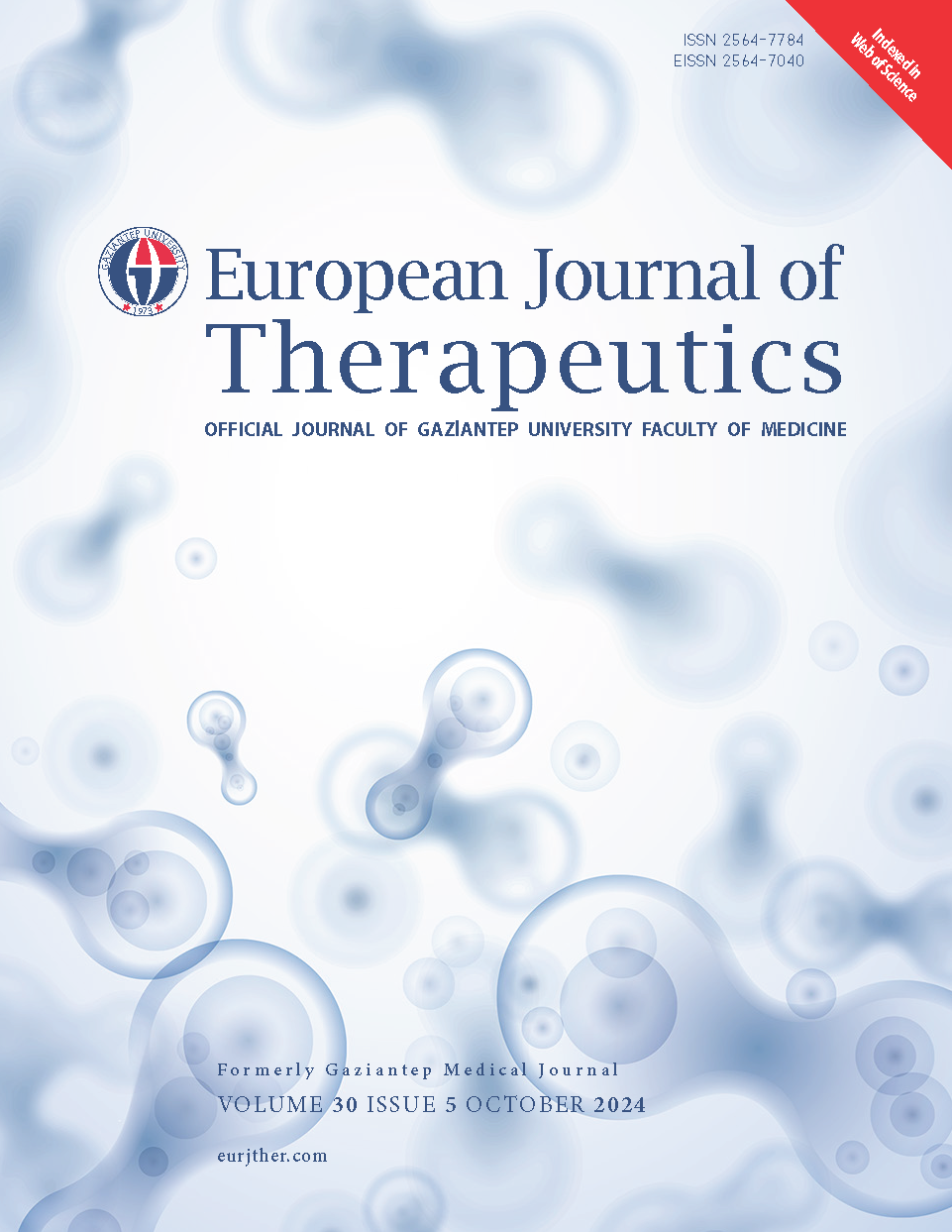Uncommon HLA Alleles Observed in a Population of Istanbul Province
DOI:
https://doi.org/10.58600/eurjther2163Keywords:
uncommon Human leukocyte antigen alleles,, Next generation sequencing, Sequencing Based TypingAbstract
Objective: New polymorphisms are formed in human leucocyte antigen (HLA) genes with point mutations, gene conversions, and duplication, and the diversity continues to increase. Various new HLA alleles have significant roles in transplantation, and epidemiologic and population studies. The aim of our study was to determine the status of HLA alleles in the Turkish population, which is uncommon, well-defined, and non-defined in the world population according to the international ImMunoGeneTics information system® (IMGT) database.
Methods: We performed HLA-A, -B, -C, -DQB1, and DRB1 loci at the four-field resolution level, using Sanger- sequence-based typing (SBT) for 5592 healthy, unrelated bone marrow donor volunteers from Istanbul Province. The uncommon alleles were also confirmed using high-throughput next-generation sequencing (NGS).
Results: Uncommon alleles were determined at five loci as follows: HLA-A*01:155, 02:66, 02:90, 02:110, 02:343, 03:82, 24:28, 24:146, 24:276, 24:356, 31:23,33:33, 68:38; HLA-B *07:240, 18:19, 35:193, 40:303, 51:69, 51:169; HLA-C*04:39, 06:40, 07:93, 12:149, 15:73; HLA-DRB1*11:149, 13:14:02 and HLA-DQB1*03:27. All alleles were arranged according to the common and well‐documented (CWD) 3.0.0 catalog.
Conclusion: This is the first study to show uncommon alleles in our population. These reported data increase the knowledge of HLA polymorphisms in the Turkish population and provide a basis for further studies in population genetics. This information may also be useful in determining whether a matched, unrelated donor is unlikely to be found so that a mismatch strategy, an extended family search, or alternate therapy, can be pursued, thus saving time and cost for patients.
Metrics
References
Kelly A, Trowsdale J (2019) Genetics of antigen processing and presentation. Immunogenetics. 71:161-170. https://doi.org/10.1007/s00251-018-1082-2.
Robinson J, Halliwell JA, Hayhurst JD, Flicek P, Parham P, Marsh SGE (2015). The IPD and IMGT/HLA database: allele variant databases. Nucleic Acids Res. 43:423–31. https://doi.org/10.1093/nar/gku1161.
Daly AK (2013). Pharmacogenomics of adverse drug reactions. Genome Med. 5:5. https://doi.org/10.1186/gm409.
Gough SCL, Simmonds MJ (2007). The HLA region and autoimmune disease: associations and mechanisms of action. Curr Genomics. 8:453–65. https://doi.org/10.2174/138920207783591690
Erlich H (2012). HLA DNA, typing: past, present, and future. Tissue Antigens 80:1–11. https://doi.org/10.1111/j.1399-0039.2012.01881.x.
Dunn PPJ (2011). Human leucocyte antigen typing: techniques and technology, a critical appraisal. Int J Immunogenet. 38:463–73. https://doi.org/10.1111/j.1744-313X.2011.01040.x.
Seyhun Y, Kekik C, Karahan G, Oguz SF, Carin MN (2008). Undetected HLA-A,B Antigens by serological method and application of molecular methods. Gaziantep Med. Journal. 14:41-45. https://doi.org/10.58600/eurjther.2008-14-1-1357-arch.
Gonzalez-Galarza FF, McCabe A, Melo Dos Santos EJ, Takeshita L, Ghattaoraya G, Jones AR, Middleton D (2018). Allele Frequency Net Database.Methods Mol Biol. 1802:49-62. https://doi.org/10.1007/978-1-4939-8546-3_4.
Robinson J, Barker DJ, Georgiou X, Cooper MA, Flicek P, Marsh SGE (2020). IPD-IMGT/HLA Database. Nucleic Acids Res. 8:948-955. https://doi.org/10.1093/nar/gkz950.
Kaur G, Mehra N. (2009). Genetic determinants of HIV-1 infection and progression to AIDS: immune response genes. Review Tissue Antigens.74:373-85.https://doi.org/10.1111/j.1399-0039.2009.01337.x.
Hurley CK, Kempenich J, Wadsworth K, Sauter J, Hofmann JA, Schefzyk D, Schmidt AH, Galarza P, Cardozo MBR, Dudkiewicz M, Houdova L, Jindra P, Sorensen BS, Jagannathan L, Mathur A, Linjama T, Torosian T, Freudenberger R, Manolis A, Mavrommatis J, Cereb N, Manor S, Shriki N, Sacchi N, Ameen R, Fisher R, Dunckley H, Andersen I, Alaskar A, Alzahrani M, Hajeer A, Jawdat D, Nicoloso G, Kupatawintu P, Cho L, Kaur A, Bengtsson M, Dehn J (2020). Common, intermediate and well-documented HLA alleles in world populations: CIWD version 3.0.0. HLA. 95:516-531. https://doi.org/10.1111/tan.13811.
Schreuder GM, Hurley CK, Marsh SG, Lau M, Fernandez-Vina M, Noreen HJ, Setterholm M, Maiers M (2005). World Marrow Donor Associations Quality Assurance and IT Working Groups; WHO Nomenclature Committee for Factors of the HLA system; 13th International Histocompatibility Workshop Serology Component; International Cell Exchange, UCLA; US National Marrow Donor Program. The HLA Dictionary 2004: a summary of HLA-A, -B, -C, -DRB1/3/4/5 and -DQB1 alleles and their association with serologically defined HLA-A, -B, -C, -DR and -DQ antigens. Tissue Antigens. 65:1-55. https://doi.org/10.1111/j.1399-0039.2005.00350.x.
Burek Kamenaric M, Maskalan M, Grubic Z, Stingl Jankovic K, Zunec R (2020). Detection of novel and confirmation of very rare and rare HLA alleles by next generation sequencing in Croatia. HLA. 96:70-75. https://doi.org/10.1111/tan.13905.
Pingel J, Solloch UV, Hofmann JA, Lange V, Ehninger G, Schmidt AH. (2013). High-resolution HLA haplotype frequencies of stem cell donors in Germany with foreign parentage: how can they be used to improve unrelated donor searches? Hum Immunol. 74:330-40. https://doi.org/10.1016/j.humimm.2012.10.029.
Jawdat D, Uyar FA, Alaskar A, Müller CR, Hajeer A. (2020). HLA-A, -B, -C, -DRB1, -DQB1, and -DPB1 Allele and Haplotype Frequencies of 28,927 Saudi Stem Cell Donors Typed by Next-Generation Sequencing. Front Immunol. 22:11:544768. https://doi.org/10.3389/fimmu.2020.544768.
Yang KL, Chen MJ, Shyr MH, Lin CL, Lin PY. (2011). Rare HLA alleles and their predicted haplotypes in Tzu Chi Taiwanese marrow donor registry. Int J Immunogenet. 38(3):263-7. https://doi.org/10.1111/j.1744-313X.2010.00992.x.
Petersdorf EW (2013). The major histocompatibility complex: a model for understanding graft-versus-host disease. Blood. 12;122:1863-72. https://doi.org/10.1182/blood-2013-05-355982.
Downloads
Published
How to Cite
License
Copyright (c) 2024 European Journal of Therapeutics

This work is licensed under a Creative Commons Attribution-NonCommercial 4.0 International License.
The content of this journal is licensed under a Creative Commons Attribution-NonCommercial 4.0 International License.


















